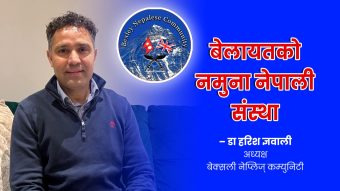Bringing Nepali Literature to the World: From Margins to the Global Stage




Dr Sangita Shrestha ‘Swechcha’
London: Nepali literature spans poetry, short stories, novels, essays, drama, and translations, yet remains largely invisible in global literary circuits. The eighth session of Nepal Dialogue Webinar, hosted by the Centre for Nepal Studies UK (CNSUK), brought together three figures deeply engaged with this challenge: scholar-translator Prof. Michael Hutt, author-translator Manjushree Thapa, and academic Dr Bal Ram Adhikari. I had an opportunity to moderate the conversation that traced the history of Nepali literature in translation, assessed its current state, and explored what it will take to move from the margins of world literature to a more central place.
Michael Hutt: Translation as Understanding and Outreach
Michael Hutt’s personal journey mirrors the slow maturation of Nepali literary translation. His engagement began in the 1970s with translations of Muna Madan, followed by landmark works, such as Himalayan Voices: An Introduction to Modern Nepali Literature and Mountains Painted with Turmeric (a novel by Lil Bahadur Chettri translated from Nepali to English). His most recent project, Karnali Blues (Penguin Random House), is among the few Nepali novels to find an international publisher.
Yet, as Hutt noted, even acclaimed works struggle to reach unfamiliar readers. Most of Karnali Blues’ copies sold were purchased in Nepal. For Hutt, the readership question is crucial: “How far can Nepali literature reach people who have never heard of Nepal?” He sees a growing pool of skilled translators and increasing output in Nepali, English, and other languages, but warns that international publishers must approach Nepali works as literature rather than ethnography if global readership is to grow.
Manjushree Thapa: Representing Nepal’s Many Voices
Manjushree Thapa placed the discussion in the broader context of Nepali writing in English. After a brief surge in the mid-20th century with figures like Laxmi Prasad Devkota, the tradition thinned until the 1970s’ revival by writers such as Peter Karthak and Greta Rana. From the 1990s, authors like Thapa herself and Samrat Upadhyay emerged from English-medium schooling to tell Nepali stories directly in English.
She believes the time has come to bring these stories to wider audiences beyond the “Nepal-interested” niche, but raises concerns about diversity in translation. Much of the country’s literature exists in Maithili, Bhojpuri, Tharu, Tamang, Magar, and other languages, yet remains untranslated into English. Without translators from these linguistic communities, large parts of Nepal’s literary reality risk remaining invisible.
Thapa also highlighted barriers for domestic and diaspora readers. Despite growth in private publishing and book cafes, access remains fragmented. Readers often do not know where to find specific titles, reliable reviews are scarce, and booksellers rarely act as informed guides. For her, a vibrant literary culture requires trustworthy criticism, targeted literary prizes (such as targeted for women writers), and organised distribution networks.
Bal Ram Adhikari: Crossing Borders, Building Discourse
Dr Bal Ram Adhikari approached the topic historically, outlining four distinct phases of Nepali literature in translation. The pioneer phase, led by Devkota and Shyam Das Baishnav, connected Nepali writing to audiences abroad for the first time. The 1960s saw little progress, aside from multiple translations of King Mahendra’s book. In the 1970s, translation expanded into new genres, though native Nepali translators remained few. By the 1990s, the number of translated works had risen, academic studies of Nepali literature had entered universities, creative writers in English were emerging, and dedicated translators had joined the scene.
For Adhikari, translation is not just about crossing national borders but also linguistic ones. Even literature written originally in English, he argued, is a kind of translation, since its characters would speak Nepali or other local languages in real life. He stressed that academic discourse—reviews, critical essays, and public debate—is essential for legitimising translation efforts. Most translations from Nepal go unreviewed, limiting their impact. Quoting Foucault, he argued that without sustained “meta-discourse,” literary translation cannot be institutionalised.
Prospects and Promises
Despite these challenges, the panelists expressed optimism. The number of literary works in English, both original and translated, is growing. New translators are emerging, translation sessions now feature in literary festivals, and public awareness is increasing. Institutions such as the Nepal Academy have dedicated translation departments and prizes, and digital publishing offers new avenues for global access.
Yet the path forward demands more than isolated efforts. Greater representation of Nepal’s many languages in translation is vital to reflect the country’s full cultural range. Partnerships with international publishers who treat Nepali works as serious literary contributions, rather than anthropological curiosities, will be essential. At the same time, Nepal needs stronger infrastructure for literary culture, reliable reviews, organised distribution, informed bookselling, and sustained critical engagement that gives translations the recognition they deserve.
From Recipient to Donor
A recurring theme of the discussion was the shift from Nepal as a recipient of global literature to a donor, offering its own stories to the world. As Adhikari put it, this is “not a luxury in Nepali literature but a necessity.” For Thapa, telling Nepali stories in English is part of claiming space in the global imagination. For Hutt, the challenge is ensuring those stories reach beyond the already-interested to genuinely new readers.
The session held earlier this month concluded with a fruitful discussion, as audience members engaged the panelists with questions and concerns, adding further depth to the conversation.
Bringing Nepali literature to the world will require creative ambition, translation diversity, publishing professionalism, and critical infrastructure working together. The work is already underway—but whether it remains at the margins or makes meaningful progress towards moving into the mainstream will depend on how these efforts converge in the years ahead.
-Dr Sangita Shrestha ‘Swechcha’, CNSUK
सम्बन्धित सामग्रीहरू
हाम्रो सिफारिस
- १
- २
- ३
- ४
- ५











